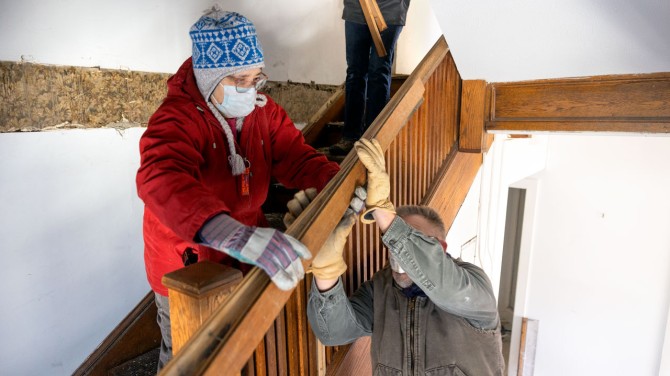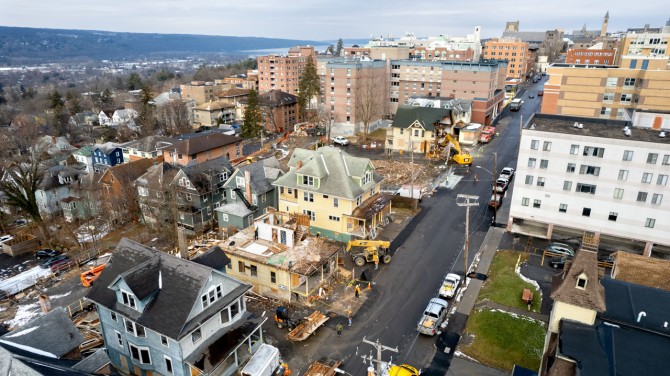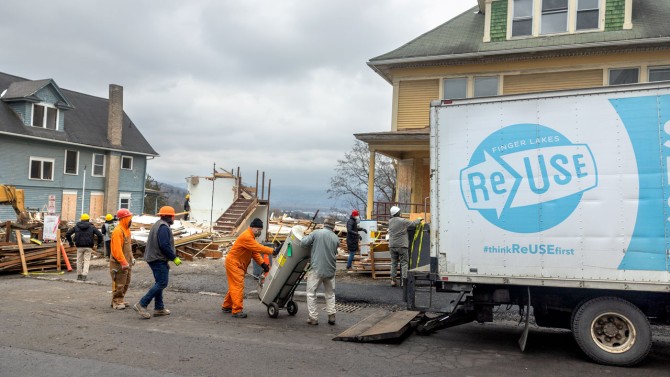Unbuild better: a Collegetown case study in deconstruction
By James Dean
On a Collegetown corner last month, a Caterpillar excavator swiftly smashed an early 1900s home to pieces, then deposited piles of mangled wood, bricks and insulation into dumpsters headed for a landfill.
The home was one of 11 spanning more than a city block, all formerly serving as student apartments, that were making way for the Catherine Commons development. Nine others were slated to be demolished in similar fashion.
But two doors down at 206 College Ave., Felix Heisel, assistant professor of architecture in the College of Architecture, Art and Planning (AAP), watched in a yellow hard hat as an alternative process unfolded – deconstruction.
Over five days there, a crew of up to eight workers methodically carved the 4,500-square foot, 13-bedroom structure into sections from top to bottom. Panels of roof, walls and floor as large as 8 by 18 feet were then hauled to an Ithaca warehouse for the materials to be salvaged and eventually resold.
“It’s fantastic to see this building slowly being unbuilt, story by story, and learning the techniques involved,” Heisel said. “You see a potential reactivation of the materials into a marketplace, and with that a second life in a new application.”
Heisel hopes the deconstruction project spearheaded by his Circular Construction Lab and a team of community partners – supported by a grant from the David M. Einhorn Center for Community Engagement – serves as a local case study promoting a more sustainable approach to building materials across the region. The results will inform local policy proposals that, if enacted, would make Ithaca one of a small number of U.S. cities prioritizing material and building reuse over downcycling and landfilling.
Globally, Heisel said, buildings over their life cycle are responsible for about 40% of greenhouse gas emissions, making them a major factor in climate change. In the United States in 2018, the construction and demolition of buildings alone generated nearly 190 million tons of debris, the overwhelming majority from demolition, according to the U.S. Environmental Protection Agency.
“We have to change,” Heisel said. “The question is how do we change and how quickly can we change?”
Heisel’s lab is investigating ways to reduce the built environment’s impact through smarter design of new structures that anticipates their eventual reuse – “design for disassembly” – and also by minimizing waste of existing materials.
The Collegetown case study aims to comprehensively research deconstruction’s local potential, documenting everything from the quantity and quality of materials saved to their resale market, the time and labor required, and the total cost – including environmental and social costs not typically factored into construction and demolition budgets.
Mark Milstein, clinical professor of management and director of the Center for Sustainable Global Enterprise in the Samuel Curtis Johnson Graduate School of Management, is partnering with his students in the economic analysis.
The data is expected to guide the drafting of a range of policy proposals by a coalition of community partners supporting the deconstruction project, organized as CR0WD – short for Circularity, Reuse and Zero Waste Development. Members include Finger Lakes ReUse, Cortland ReUse, Historic Ithaca, the Susan Christopherson Center for Planning and the Preservation Association of Central New York, in addition to Heisel’s lab and the Just Places Lab led by Jennifer Minner, associate professor of city and regional planning (AAP). If successful, Ithaca would follow the lead of cities including Portland, Oregon, Palo Alto and San Antonio.
Heisel said implementing deconstruction and other circular economy processes is a global aspiration that depends heavily on local conditions, which vary in their built environments, economies and stakeholders. After a year of discussions with developers, the Catherine Commons site materialized as an opportunity to advance that local knowledge late last year.
Students had already done preliminary work to model each home through a combination of surveys and laser scanning with smart devices. The scans created point cloud images that were analyzed by algorithms Heisel’s lab developed to quickly estimate the homes’ material content, from square footage and numbers of windows to pounds of timber and its embodied carbon.
That technology innovation promises to accelerate building assessments, and faster timelines are key to making deconstruction competitive with demolition, Heisel said. Developers typically want sites cleared quickly once they have approval.
Starting over the winter holidays and through icy days in early January, CR0WD mobilized dozens of community volunteers in a massive effort to rapidly “soft strip” all 11 homes being taken down, salvaging stoves and dishwashers, light fixtures, doors and original oak flooring and chestnut baseboards.
“This is pretty spectacular material that you can’t get anymore,” said Diane Cohen, director of Finger Lakes ReUse, who oversaw the effort. “There’s a real importance to saving what I think are incredibly beautiful materials. And from a purely practical sense, you’re displacing the need to harvest and produce and transport new ones, so there’s a huge energy savings.”
Cohen had recently secured a warehouse with assistance from Tompkins County, the city of Ithaca and private donors, ensuring there was somewhere to store and process the salvaged material. That’s just one example of local capacity-building that the researchers and advocates say is essential to scaling up deconstruction work.
Another is a trained work force. Heisel said the case study provided a valuable opportunity to develop “green” job skills – including for union apprentices – and created more jobs benefitting the community than the adjacent demolition site, where a single excavator operator razed a home within hours.
“That is cheaper in terms of how many labor hours you put in and what kind of equipment you need,” Heisel said, “but we carry societal costs that contribute to climate change.”
Then on Jan. 10, a team from Ithaca-based Trade Design Build and Local 785 of the Laborers International Union of North America assembled in the attic of 206 College Ave. to begin the deconstruction under a contract with Finger Lakes ReUse. The work was supported by the developer’s demolition budget for that structure and supplemented by the Einhorn Center grant.
Dave Bennink, a Washington State-based deconstruction expert, oversaw a process called panelized deconstruction. He showed where to perform incisions to safely preserve as much lumber as possible from the rafters, wall studs and ceiling and floor joists.
“We want this work to become a mainstream choice for building removal simply because it’s economically viable, because it makes sense,” said Bennink, owner of Re-Use Consulting and director of the Building Deconstruction Institute.
An extendable forklift transferred the panels to a flatbed truck that ferried them to the warehouse for further processing – primarily de-nailing – helping to expedite work at the Catherine Commons site.
It will take time to confirm the salvaged material’s monetary value, but circular economy proponents say that is only one measure of their worth. Heisel’s lab estimates the roughly 18,000 pounds of structural members saved from the one home translate to 29,000 pounds of embodied (and sequestered) carbon dioxide kept out of a landfill – equivalent to the carbon dioxide emissions from an average car driven around the equator 1.3 times or the amount of carbon dioxide sequestered by an acre of Finger Lakes National Forest. Those totals don’t include additional savings from salvaged elements such as flooring, staircases, radiators, windows and architectural components. And in addition to natural resources, Heisel said, the materials embody equally important local values such as history and human craftsmanship.
In the coming months, Heisel will track how some of the materials are reused, validate his digital models and produce a detailed cost comparison between the deconstruction and demolitions performed side by side on nearly identical sites in Collegetown, sharing the findings with academics and policymakers.
He hopes lessons learned from the case study influence policies and change in the construction industry, which he said knows its practices are wasteful but is not always aware of existing alternatives.
“Overcoming some of the norms takes time and takes effort,” Heisel said. “It takes projects like these to show what is possible, and how it can be done.”
Get Cornell news delivered right to your inbox.
Subscribe




